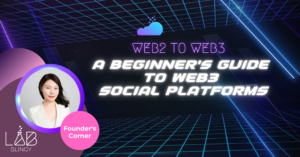The digital world is on the cusp of a groundbreaking transformation with the emergence of Web3. This next phase of the internet holds immense promise for revolutionizing industries, economies, and societies. At the core of this transformation lies the concept of Web3, which represents a paradigm shift in how we interact, transact, and collaborate online.
Understanding the transformative potential of Web3 is crucial for businesses and entrepreneurs seeking to thrive in this new digital era. One critical aspect that will shape the Web3 landscape is the rise of platform business models. By harnessing the power of platform business models within the Web3 landscape, organizations can position themselves at the forefront of innovation, collaboration, and value creation. The stage is set for a new era of digital possibilities, and platform models will be instrumental in shaping the future of Web3.
Understanding Web3
Web3 is not just an incremental upgrade from Web2; it represents a paradigm shift in how we conceive and utilize the internet. To understand the significance of Web3 and its implications for businesses, let’s delve into its definition, key characteristics, and the fundamental differences it holds compared to Web2.
1.1 Define Web3 and its Key Characteristics:
Web3, the decentralized web, refers to a new internet generation that aims to create a more open, secure, and user-centric digital ecosystem. It leverages blockchain technology, decentralized networks, and cryptographic principles to enable direct peer-to-peer interactions and redefine the relationship between users, applications, and data.
Key characteristics of Web3 include:
a) Decentralization: Web3 operates on decentralized networks, eliminating the reliance on centralized intermediaries. It empowers users by giving them more control over their digital assets, data, and identities. Decentralization also enhances security, privacy, and resilience by removing single points of failure.
b) Self-Sovereign Identity: Web3 emphasizes the concept of self-sovereign identity, where users have ownership and control over their personal information. With self-sovereign identities, individuals can selectively share their data, reducing privacy risks and empowering users to manage their online presence.
c) Interoperability: Web3 promotes interoperability between applications and platforms, allowing seamless integration and interaction. This characteristic enables data and value to flow more freely across the decentralized web, fostering innovation and collaboration.
d) Programmable Trust: Web3 relies on smart contracts, which are self-executing and tamper-proof agreements that automatically enforce predefined rules. Smart contracts enable transparent, secure, and trustless transactions, eliminating the need for intermediaries and fostering a new level of programmable trust.
1.2 Differences between Web3 and Web2 and their Implications for Businesses:
Web3 differs significantly from its predecessor, Web2, in several key aspects. Web2 was characterized by the dominance of centralized platforms, where data and control were concentrated in the hands of a few tech giants. In contrast, Web3 disrupts this centralized model, redistributing power, ownership, and control to individual users.
Implications for businesses in the Web3 era include:
a) Disintermediation: Web3 challenges traditional intermediaries by enabling direct peer-to-peer interactions. This disintermediation has significant implications across various industries, potentially reducing the need for middlemen and transforming business models. Companies will need to adapt to this decentralized landscape or risk being disrupted.
b) Data Ownership and Privacy: Web3 strongly emphasizes data ownership and privacy. Individuals have greater control over their data and can decide how it is used. This shift requires businesses to be more transparent and respect user privacy, building trust and loyalty through responsible data practices.
c) New Business Models: Web3 opens up new possibilities for innovative business models. Decentralized applications (dApps) and blockchain-based services can offer unique value propositions, such as tokenized ecosystems, decentralized finance (DeFi) solutions, and non-fungible tokens (NFTs). Businesses that embrace these new models can tap into the growing opportunities within the Web3 landscape.
The Power of Platform Business Models
In the realm of digital innovation, platform business models have emerged as a driving force, revolutionizing industries and reshaping the way we connect, collaborate, and create value. Let’s explore the concept of platform business models and their exceptional achievements during the Web2 era. Also, delve into their advantages, including network effects, scalability, and user-generated content. Furthermore, let’s explore the real-world examples of successful platform businesses that have effectively utilized these models to attain significant growth and influence.
1. Explaining Platform Business Models in Web2
Platform business models serve as intermediaries that facilitate the exchange of goods, services, or information between different user groups. These platforms create an ecosystem where users can interact, transact, and generate value. In the Web2 era, platforms like Facebook, Airbnb, and Uber have exemplified the power of this model, transforming entire industries and disrupting traditional business models. These platforms act as digital marketplaces, connecting buyers and sellers, service providers and customers, and content creators and consumers.
2. Advantages of Platform Models in Web2
a. Network Effects: One of the key advantages of platform business models is the concept of network effects. As more users join the platform, the platform’s value increases for all participants. With a larger user base, platforms can attract more sellers, which in turn attracts more buyers, leading to a virtuous cycle of growth and engagement.
b. Scalability: Platform models have a unique ability to scale rapidly. Unlike traditional business models that require extensive infrastructure and resources, platforms can leverage existing technologies and user-generated content to expand their reach. As the platform grows, it becomes more valuable, attracting more users and participants.
c. User-Generated Content: Platforms thrive on user-generated content, where users contribute their own creations, insights, or experiences. This content enhances the platform’s value and fosters community engagement and active participation. Examples of user-generated content can be found on platforms like YouTube, where users upload videos, or on social media platforms, where users share posts and interact with each other’s content.
3. Real-World Examples of Successful Platform Businesses
a. Airbnb: Airbnb disrupted the hospitality industry by creating a platform allowing homeowners to rent their properties to travelers. By connecting hosts and guests, Airbnb created a global marketplace offering unique accommodations and personalized experiences.
b. Etsy: Etsy revolutionized the world of handmade and vintage goods by providing independent artisans and craftspeople a platform to sell their products online. The platform’s focus on niche markets and unique products has attracted a dedicated community of buyers and sellers.
c. YouTube: YouTube transformed how we consume and share video content by providing a platform for users to upload and share videos. With its vast user base and diverse content offerings, YouTube has become a go-to platform for entertainment, education, and creative expression.
These real-world examples demonstrate platform business models’ immense success and impact in the Web2 era. They highlight the power of network effects, scalability, and user-generated content in driving growth and fostering vibrant ecosystems.
The Convergence of Web3 and Platform Models
As we transition into the era of Web3, the integration of Web3 technologies with platform business models holds immense potential. The synergies between Web3 technologies, such as blockchain and smart contracts, these technologies enhance platform models and foster trust, transparency, and user empowerment in a decentralized platform. Also, let’s analyze the benefits of tokenization and decentralized governance in platform ecosystems.
1. Enhancing Platform Models with Web3 Technologies
Web3 technologies, particularly blockchain and smart contracts, significantly enhance platform business models. Using blockchain’s immutable and decentralized nature, platforms can ensure transparent and secure transactions, eliminating the need for intermediaries. Smart contracts enable the automation and execution of agreements, facilitating trust and reducing transaction costs. These technologies allow platforms to create decentralized and efficient ecosystems that empower users and foster collaboration.
2. Decentralized Platforms in Web3: Trust, Transparency, and User Empowerment
Decentralized platforms are at the forefront of Web3’s transformative potential. These platforms redefine trust and transparency in online interactions by leveraging blockchain technology. Traditional platforms often centralize control and data, leading to concerns about privacy, censorship, and biased decision-making. In contrast, decentralized platforms distribute power among participants, promoting transparency and empowering users. With Web3’s decentralized architecture, platforms can create environments where users have more control over their data and decision-making processes.
3. Benefits of Tokenization and Decentralized Governance in Platform Ecosystems
Tokenization, representing real-world assets or functionalities with digital tokens on the blockchain, brings unique advantages to platform ecosystems. Tokens can incentivize user engagement, aligning the interests of platform participants. They can also enable new economic models like peer-to-peer value exchange and tokenized rewards.
Additionally, decentralized governance mechanisms, often facilitated by tokens, allow platform users to have a say in the decision-making processes of the ecosystem, ensuring fair and inclusive governance.
The convergence of Web3 technologies with platform models presents a transformative opportunity. Tokenization and decentralized governance further enhance the potential for vibrant and sustainable platform ecosystems.
Challenges and Opportunities
In the Web3 era, platform businesses face unique challenges and opportunities. However, the platform businesses’ hurdles include scalability, interoperability, and regulatory concerns. Scaling decentralized platforms to accommodate a growing user base while maintaining efficiency and performance remains a significant challenge. Ensuring interoperability between different blockchain networks and platforms is crucial for fostering seamless user experiences and expanding the reach of decentralized ecosystems. Moreover, navigating the evolving regulatory landscape presents complexities that platform businesses must address.
Even the platform business model amidst these challenges lies exciting opportunities. Platforms can leverage the emerging trends in decentralized finance (DeFi), non-fungible tokens (NFTs), and decentralized applications (dApps) to unlock new revenue streams, engage users in innovative ways, and pioneer novel business models. The intersection of platform models and these emerging areas holds immense potential for driving the next wave of digital disruption and value creation.
Strategies for Success
Embracing platform models in the Web3 era can be a game-changer for businesses seeking growth and relevance in the digital landscape. Here I would like to provide valuable insights on how businesses can successfully adopt and leverage platform models in the Web3 environment.
a. Community: It emphasizes the importance of community building, incentivization, and user-centric design as crucial elements for platform success. By fostering a vibrant and engaged community, businesses can cultivate a loyal user base and drive network effects that fuel growth. Incentivization mechanisms, such as token rewards or revenue-sharing models, can motivate user participation and contribution, fostering a self-sustaining ecosystem.
b. UGC: Additionally, adopting a user-centric design approach ensures intuitive and seamless experiences that attract and retain users.
To thrive in the Web3 platform economy, entrepreneurs and organizations should embrace these strategies and consider practical tips that encourage experimentation, collaboration, and adaptability.
Conclusion
Web3 is on the horizon, poised to revolutionize the digital landscape, and platform business models are ready to lead the charge. The decentralized nature of Web3 perfectly aligns with the inherent advantages of platform models, creating inclusive, transparent, and collaborative ecosystems. By embracing the power of platforms in the Web3 era, businesses can become influential drivers in shaping the future of the digital economy. Are you ready to join the journey and leverage the potential of platform business models to thrive in the decentralized, equitable, and prosperous Web3?
Follow my Twitter @JoyyuanWeb3 to learn about the trends of Blockchain, Crypto, Metaverse, and Web3!








